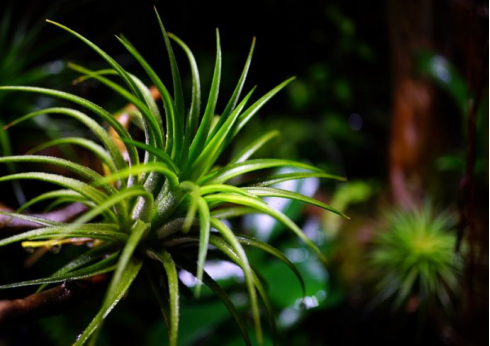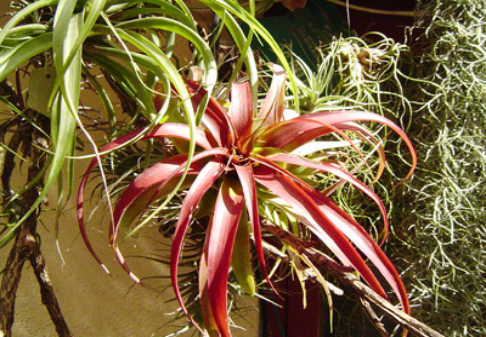What if the air pineapple leaves turn yellow?
Reduce watering
Watering has a lot of knowledge, not too much watering, under normal circumstances, the soil surface is slightly dry when watering, the amount of water should not be too large.
Reduce the light
You can put it on the balcony, when the light is strong, you can shade it appropriately, or you can move it slightly, on the contrary, you can't keep it in the shade for a long time, you should have appropriate light.
Ventilation
Proper ventilation, or occasionally opening windows at night, is conducive to its growth in a ventilated environment.
Warm up to keep out the cold
You can take some measures to keep warm in a low temperature environment, or put it in the sun when the sun is good, and properly control watering.

What if the pineapple leaves turn yellow? The solution to the yellowing of pineapple leaves pineapple is generally short for ornamental pineapple, which is a more famous holiday flower. In fact, it is the pineapple that we usually see, but a kind of flower we see in the flower market should actually be called ornamental pineapple. Sometimes businesses casually cut it short and say it is pineapple. Many flower friends buy pineapple at home for a period of time and find that the pineapple leaves are yellow. I don't know what happened to the pineapple. After reading the following article, we must be able to know how to solve the problem of yellowing leaves. The yellow and withered leaves may be caused by the following reasons: 1. It may be that the water quality of irrigation is too alkaline or high in calcium and sodium. two。 The humidity in the indoor air is too low. 3. Excessive fertilization or too high concentration of liquid fertilizer leads to salt damage and protoplast separation and dehydration. 4. Poor drainage caused the root of the pineapple to rot. Solution: if it is the root of the leaves yellowing is fine, normal phenomenon, just cut it off. Pineapple is native to the tropics and is afraid of the cold, so the temperature should reach more than 5 ℃ in winter, so as to avoid pathological changes. Because the original state of the pineapple itself is parasitic in the tropical rain forest, so the need for sunlight is not too high, but more sunlight, but also lead to yellow leaves, flower tips dry and so on. Therefore, the place where the pineapple flowers are placed had better be in a semi-overcast and ventilated place to prevent the exposure of the hot sun. Topdressing 1Mel twice a month, the basin soil can be moist, the root of the pineapple leaf has a leaf tube, the leaf tube has a sink, as long as you keep water in the sink. But the water inside had better be changed every half a month so as not to stink. Usually, we should sprinkle some water on the flowers and leaves to improve the humidity of the environment. After winter, you should move indoors to keep warm and keep room temperature for 5 ℃. In case of extra cold, you can put plastic bags on the basin to warm up. Turning the basin and changing the soil is carried out every 1-2 years. The basin soil can be mixed with 5 parts of mud, 4 parts of sand, 1 part of rice chaff ash or mature sawdust. If a small amount of bone meal is added to the soil, it is better. Water uses ionized water or mineral water. The PH of tap water is higher. The day before watering, it is best to store the water in the greenhouse for one day, or you can use a thermometer to measure its water temperature to ensure that it is above 20 degrees. When dispensing fertilizer, it is directly mixed with deionized water. Generally speaking, the proportion of nitrogen, phosphorus and potassium in it is 20:10:20, because pineapple does not like too much phosphate fertilizer. If there is too much phosphate fertilizer, it will affect the growth of its root system. Then it likes nitrogen and potassium, but if there is too much nitrogen fertilizer, it will also cause the leaves to grow excessively. In general, the ratio of nitrogen fertilizer to potassium fertilizer is about the same, nitrogen, phosphorus and potassium 20:10:20. The general fertilization cycle is about half a month, and during its growth, you can take it out of the basin and observe the color of its root system. If the color of the root is dark, it proves that its fertilizer concentration is more suitable for its growth. If the root is a little white, you can appropriately increase its concentration or shorten the interval period. When applying fertilizer, we should pay attention to increase the application of potassium fertilizer and magnesium fertilizer, reduce the amount of phosphate fertilizer, and strictly control the application amount of copper and boron. Conclusion: the above is about the reasons for the yellowing of pineapple leaves and the introduction of solutions. I hope you can share more experience in pineapple conservation. Pineapple leaves yellowing what to do pineapple leaves yellowing reason introduction pineapple, we may be a little strange, but when it comes to pineapple everyone is particularly familiar with, people in order to closely watch pineapple flowers, studied the ornamental pineapple flowers, but, in the planting process there are a variety of problems, such as pineapple leaves yellowing, then, pineapple leaves yellowing how to do? What is the reason for the yellow leaves of pineapple? Follow the editor of Provincial many Decoration Network to have a look! The reason for the yellowing of the leaves of heather pineapple may be that the irrigation water quality is too alkaline or contains high calcium and sodium; the air humidity is too low; excessive fertilization or the concentration of liquid fertilizer is too high, resulting in salt accumulation in the leaf tips, resulting in salt damage, protoplast separation and dehydration; poor drainage of the substrate, resulting in rotten roots, water can not be fully supplied to the leaf tips, and so on. Because the original state of pineapple is parasitic under a tree in the tropical rain forest and so on, habits like semi-shade, should prevent hot sun exposure, should be placed in half-shade or bright indoor or window. So the demand for sunlight of pineapple is not very great. So when you spend too much time in the sun, it produces part of the leaves yellowing, and then the tip of the flower begins to dry and yellow. How should pineapple leaves turn yellow? topdressing 1 Mel 2 times a month, the potted soil can be moist, do not cut off water in the roll hole, and increase the number of foliar water spraying to improve environmental humidity. After winter, you should move indoors to keep warm and keep room temperature for 5 ℃. In case of extra cold, you can put plastic bags on the basin to warm up. Turning the basin and changing the soil is carried out every 1-2 years. The basin soil can be mixed with 5 parts of mud, 4 parts of sand, 1 part of rice chaff ash or mature sawdust. If a small amount of bone meal is added to the soil, it is better. Water uses ionized water or mineral water. The PH of tap water is higher. The day before the golden bell is planted and watered, it is best to store the water in the greenhouse for one day, or you can use a thermometer to measure its water temperature to ensure that it is above 20 degrees. When dispensing fertilizer, it is directly mixed with deionized water. Generally speaking, the proportion of nitrogen, phosphorus and potassium in it is 201020, because pineapple does not like too much phosphate fertilizer. If there is too much phosphate fertilizer, it will affect the growth of its root system.
Then nitrogen and potassium are preferred, but if there is too much nitrogen fertilizer, it will also cause the leaves to grow excessively. Generally speaking, the ratio of nitrogen fertilizer to potassium fertilizer is about the same, nitrogen, phosphorus and potassium 201020. The general fertilization cycle is about half a month, and during its growth, you can take it out of the basin and observe the color of its root system. If the color of the root is dark, it proves that its fertilizer concentration is more suitable for its growth. If the root is a little white, you can appropriately increase its concentration or shorten the interval period. When applying fertilizer, we should pay attention to increase the application of potassium fertilizer and magnesium fertilizer, reduce the amount of phosphate fertilizer, and strictly control the application amount of copper and boron.
Culture methods and precautions of pineapple plants of different genera tolerate different degrees of light. Some people can withstand full tropical sunlight, while others may soon burn. In general, however, pineapple plants prefer well-lit, bright windowsills rather than direct sunlight. A south, west or east window is often perfect. Yellow plants may receive too much light, while plants are dark green, or elongated, and may receive too little light. The temperature of the water Phoenix pear flower is very resistant to drought. In a normal house, it is not necessary to keep the cup filled with water in the center, but if the illuminance, temperature and humidity are high enough, this is an option. If you concentrate water on the pineapple, be sure to rinse the central cup at regular intervals to remove any built-in salt. However, in general, it is enough water for these plants to pass through the soil every week during the growing season and reduce watering during the winter rest time. Don't let your factory rest in stagnant water. Potted soil
Although they are epiphytes, pineapple plants can grow in a rapidly draining potted soil. A mixture of peat and peat soil and a mixture of sand and sand is the best method. Pineapple can also grow and grow in other soils. These plants need to be watered frequently.
- Prev

Air pineapple after flowering
Ramets are usually carried out after the death of the mother plant of air pineapple. Cut off the tufted withered leaves on the mother plant, and then gently break off the seedlings with your hands, which is basically effortless. Don't lose the mother plant immediately. The withered air pineapple may produce more ramets.
- Next

Main pests and diseases of bamboo
Aphids, blowing scales, round shield scales and black caterpillars and other hazards. all right
Related
- Fuxing push coffee new agricultural production and marketing class: lack of small-scale processing plants
- Jujube rice field leisure farm deep ploughing Yilan for five years to create a space for organic food and play
- Nongyu Farm-A trial of organic papaya for brave women with advanced technology
- Four points for attention in the prevention and control of diseases and insect pests of edible fungi
- How to add nutrient solution to Edible Fungi
- Is there any good way to control edible fungus mites?
- Open Inoculation Technology of Edible Fungi
- Is there any clever way to use fertilizer for edible fungus in winter?
- What agents are used to kill the pathogens of edible fungi in the mushroom shed?
- Rapid drying of Edible Fungi

